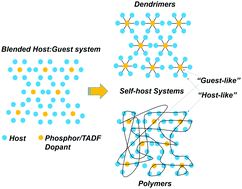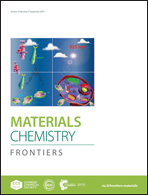Phosphorescent and TADF polymers and dendrimers in solution-processed self-host organic light-emitting diodes: structure analysis and design perspectives
Abstract
Small-molecule emitters that are phosphorescent or exhibit thermally activated delayed fluorescence have permitted, when doped into an appropriate host, the fabrication of organic light-emitting diodes with internal quantum efficiencies approaching 100% and external quantum efficiencies above 25%. However, by omission of the host materials, device fabrication can potentially be simplified. Host-free devices, which utilize a neat thin film of the emitter as the emissive layer, often suffer from issues arising from aggregation, such as luminescence quenching and spectral shift, and in many cases show poor roll-off in efficiency with luminance. Self-host materials – polymers or dendrimers that contain both emitter-like and host-like structural attributes – are one approach to host-free devices. Despite the development of a large number of such materials, only a few have shown external quantum efficiencies in self-host devices that approach those of traditional host:guest emissive layers (ca. 20%). In this review, we attempt to critically analyze the structures of representative examples of materials developed to date in an attempt to correlate their physical properties to electroluminescent properties. It is hoped that our survey will help to identify the design problems, as well as providing directions towards development of new polymers/dendrimers that perform as better self-host materials.

- This article is part of the themed collections: In Honour of Professor Robert H. Grubbs for His 50-year Contributions in Metathesis and 2019 Materials Chemistry Frontiers Review-type Articles


 Please wait while we load your content...
Please wait while we load your content...